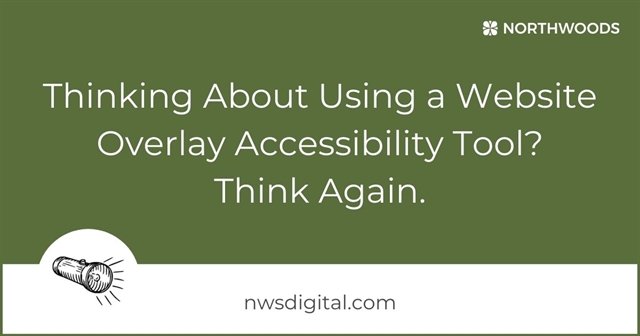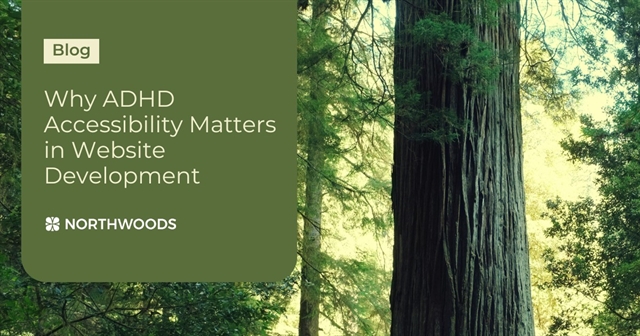By Sydney Shimko
March 11, 2024
7 Minute Read
As a web developer, I work every day in intentional ways to ensure that the applications and sites I build are as accessible as I can make them. I’m consistently disappointed when reminded of the slow pace of improvement in web accessibility globally.
Out of whimsy and curiosity, I asked ChatGPT why we, as a collective group of website designers, developers, owners and managers, seem to progress so slowly. I was struck by the response from ChatGPT, which was quick to recycle the same crummy excuses. Nearly all of these excuses are easy to debunk.
It’s also dismaying that most of the top web accessibility errors have remained almost completely unchanged in the past five years. Why haven’t we made more progress?
Let’s look at some of the most common myths and misinformation surrounding website accessibility, why they continue to impede our ability to create a more inclusive web, and what we can do to impact positive change.
Top Myths & Misinformation About Web Accessibility
1. Lack of Awareness
If web designers, developers, and website managers aren’t already aware of the importance of web accessibility standards and how to meet them, then we are certainly failing as an industry. Accessible best practices for web development aren’t new.
Web developers are constantly adapting to changing digital environments. Learning the principles and importance of web accessibility is no different than jumping on the latest design trend or development framework. It’s sometimes true that adapting behaviors and affecting change can take a long time, but that shouldn’t be an excuse not to start. As you’ll see in #2, as web developers and site owners, we’re really good at learning and evolving.
What You Should Do: Don’t prioritize the appeal of design and development “disruption” over meaningful change that can simplify and improve common tasks for all internet users.
2. Rapid Technological Changes
Because web development technologies are constantly evolving, web developers sometimes argue they can’t keep up with the latest accessibility guidelines and best practices. But here’s the thing: While how we build the web might change rapidly (think DIY website builders and AI-powered tools), web accessibility guidelines and best practices have never changed quickly.
In fact, WCAG 2.2 was finally released in 2023, with the previous updates coming 5 years earlier and 10 years before that. Many of today’s newest web developers never knew a web development world that didn’t include WCAG 2.1 (2018). Moreover, WCAG 2.2 (2023) is backward compatible with WCAG 2.1, meaning that it adds a small number (9) of new principles to address how our digital landscape continues to evolve to a greater number of mobile devices and new interface types. The previous 78 criteria for web accessibility success are nearly unchanged (one criteria was removed as obsolete).
What You Should Do: Recognize that it’s a myth that web accessibility guidelines and best practices constantly change.
3. Resource Constraints
Resource constraints related to a web project often include time, budget, and expertise. A limit in any of these areas is often more accurately described as a de-prioritization. When the response is “We can’t afford to…”, the rebuttal should be “You can’t afford not to…”!
It’s difficult to quantify the cost of adverse impact to users. It’s also difficult to quantify how many customers you may lose (or never gain) due to negative user interactions with an inaccessible website. But several things are well known:
- Promoting an accessible website can positively impact your brand appeal.
- Retrofitting existing code and web infrastructure with accessibility best practices is significantly more expensive than including it in a new project from the start.
- The cost of web accessibility lawsuits can be huge. Settling a lawsuit may cost a small business $5,000, and that doesn’t include required website remediation. Decisions involving large corporations have been as costly as $6 million. According to accessibility.com, 2,281 website accessibility lawsuits were filed in 2023 alone.
What You Should Do: Help colleagues understand the possible negative effects of not focusing on accessibility, both in terms of dollars, time, and organizational image.
4. Implementation Complexity
While implementing large interactive websites and applications can be complex, the “you can’t afford not to” rebuttal from above applies here. The most complex implementations are those that attempt to retrofit existing, inaccessible websites and apps to meet accessibility standards.
If you don’t include accessibility as a goal at the start of a new website or application development project, you’re essentially fulfilling the prophecy of complexity – and kicking what will undoubtedly become significantly larger costs further down the road.
What You Should Do: Make sure accessibility is a focus at the start of all new website projects. Build accessibility into your project goals and KPIs. Help team members and the company leaders who approve budgets understand that spending more now will ultimately save money (and time) in the long run.
5. Inconsistent Enforcement of Regulations
Around the globe, we have one shared and consistent standard for web accessibility: The Web Accessibility Guidelines (WCAG). What’s inconsistent are the monitoring, regulation, and penalties for non-compliance against the shared standard. This leaves organizations playing a potentially costly game of chance where first, their users pay the cost with user-unfriendly websites, and second, the organizations’ budget and image could suffer negative impacts from a lawsuit.
What You Should Do: Focus on your users first by making accessibility a priority. This will help avoid any potential lawsuits, improve the user experience for all website visitors, and help contribute to positive PR.
6. Limited User Feedback
Lack of feedback as a reason why your website isn’t accessible puts the onus of the problem back on the user, when the true responsibility to fix it sits squarely on the shoulders of web developers and website owners.
When a user has reached the limits of their frustration attempting to complete a simple task on the web, the last thing they may want to do is reach out with constructive feedback - especially if the site they’re struggling with doesn’t offer an accessible way to do so. Instead, you may find disgruntled users seeking legal action or moving to an accessible platform of their choice to share their negative experience with your brand.
What You Should Do: Make sure your website offers an easy way for users to provide feedback. In addition to an accessible form for users to send input, you can provide a phone number, email address, and physical location where users can reach out directly to get the information they came to acquire .
Consider adding an accessibility policy to your site, as well. Having an accessibility policy shows that you’re serious about creating an inclusive online experience.
7. Testing and Quality Assurance Challenges
It’s true that comprehensive accessibility testing can sometimes be complicated, but it doesn't have to be. Any amount of testing is better than no testing at all. When best practices are followed from the start, a small amount of testing and remediation work can quickly expose and remove simple errors that could otherwise have cascading effects across the site.
While automated tools may only catch about 20% of errors, that isn’t a reason to ignore testing. Instead, use automated tools to catch and fix those 20% of errors. After that, employing (at least) a small amount of real user testing for keyboard interaction and using assistive technology devices to identify other issues can bring you another leap forward in providing an accessible experience.
Without the most robust testing that includes automated, manual, and assistive approaches, some errors may indeed go unnoticed. But without any testing at all, simple errors will certainly be present.
What You Should Do: Don’t throw the baby out with the bath water thinking testing is too difficult to undertake. Start small and build from there.
Final Thoughts
When the top accessibility errors found across the web are detected with automated testing, they can often be solved with the simplest of fixes. Adding alternative text, confirming that color contrast is sufficient, and ensuring proper hierarchy and labeling of elements across web pages are just a few examples.
At the end of my conversation with ChatGPT, it attempted to placate my concerns for our broken web with promises that accessibility advocates, organizations, and standards bodies are working hard to promote a culture of inclusive design. While true and laudable, we can do so much better!
Every one of us is responsible for building a better, more intentional, and more inclusive internet. No more excuses. Let’s get to work!
If you’re concerned your website isn’t meeting WCAG accessibility standards, an expert audit is a great way to identify issues and create an actionable remediation plan. Northwoods can help. Learn more and reach out today.
Related Blog Posts

Many accessibility tools and products on the market “bolt on” to your website as third-party scripts or plugins. They claim to make websites more accessible to end users and/or protect site owners from accessibility lawsuits. Sounds like a great, easy solution, right? Here's what you need to know.

Despite documented disability numbers, growing lawsuits, established and mature accessibility guidelines, and even Federal accessibility requirements for certain businesses that receive government funds, most companies continue to ignore web accessibility – to their peril. Don't be one of them!

We tend to think about web accessibility in terms of visual and physical impairments. But how does having a neurodivergent disorder like ADHD alter a user’s experience of the web? And how can website managers make their site a friendlier place for them?